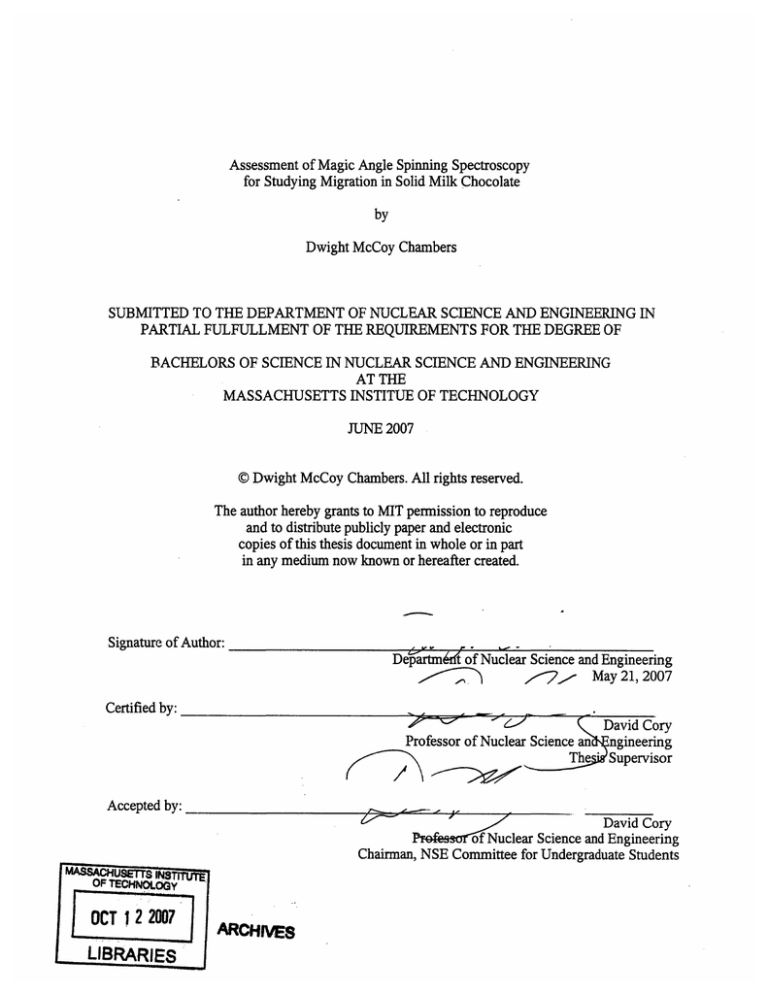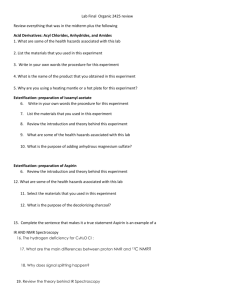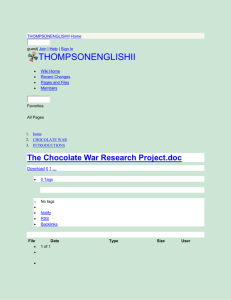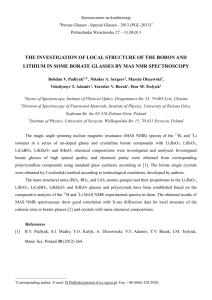
Assessment of Magic Angle Spinning Spectroscopy
for Studying Migration in Solid Milk Chocolate
by
Dwight McCoy Chambers
SUBMITTED TO THE DEPARTMENT OF NUCLEAR SCIENCE AND ENGINEERING IN
PARTIAL FULFULLMENT OF THE REQUIREMENTS FOR THE DEGREE OF
BACHELORS OF SCIENCE IN NUCLEAR SCIENCE AND ENGINEERING
AT THE
MASSACHUSETTS INSTITUE OF TECHNOLOGY
JUNE 2007
© Dwight McCoy Chambers. All rights reserved.
The author hereby grants to MIT permission to reproduce
and to distribute publicly paper and electronic
copies of this thesis document in whole or in part
in any medium now known or hereafter created.
Signature of Author:
Signature
rtmof Author:
t of Nuclear Science and Engineering
/"-7/
May 21, 2007
Certified by:
David Cory
Professor of Nuclear Science an ngineering
Theh ' Supervisor
Accepted by:
MASAcHuSS
David Cory
ef
f Nuclear Science and Engineering
Chairman, NSE Committee for Undergraduate Students
INSTITU
OF TECHNOLOGy
OCT 12 2007
LIBRARIES
ARCHIVES
Assessment of Magic Angle Spinning Spectroscopy
for Studying Migration in Solid Milk Chocolate
by
Dwight McCoy Chambers
Submitted to the Department of Nuclear Science and Engineering on May 21, 2007
In Partial Fulfillment of the Requirements for the Degree of
Bachelor of Science in Nuclear Science and Engineering
Abstract
In the confectionery industry, there is considerable interest in understanding the mechanisms of liquid
lipid migration inside chocolates as it relates to combating fat-bloom defects in confectionery products.
[1] This thesis investigates the ability of MAS NMR spectroscopy to adequately resolve chocolate
spectra and deliver diffusion data specific to individual chemical species. Using a Bruker 300 MHz
spectrometer equipped with liquid state and hr-MAS probes various spectroscopic characteristics of a
milk chocolate sample were recorded. The MAS spectrometer resolved the chocolate spectrum into
individual chemical signals and demonstrated multi-compartment diffusion behavior.
Thesis Supervisor: David Cory
Title: Professor of Nuclear Science and Engineering
Table of Contents
Abstract
List of Figures
List of Tables
1. Introduction
1-1. NMR Spectroscopy of Chocolates and the Fat Blooming Phenomena
1-2. Magic Angle Spinning (MAS) Spectroscopy of Solids in NMR
1-3. Stimulated Echo and its Application to Diffusion Measurements
2. Methodology
2-1. Sample Preparation
2-2. T1, T2, and Diffusion NMR Experiments
2-3. MAS NMR Experiments
3. Data Analysis and Results
3-1. Gross Sample Relaxation Characteristics and Diffusion Behavior
3-2. MAS NMR Spectrum and Diffusion Measurements
4. Discussion
5. Conclusions
References
Acknowledgments
2
4
5
6
6
7
8
10
10
10
12
14
14
16
19
20
21
22
List of Figures
Figure 1: Cartoon of chocolate
Figure 2: Visual comparison of normal milk chocolate and milk chocolate with fat bloom
Figure 3: Illustration of sample in MAS configuration
Figure 4: Generalized Stimulated Echo with Continuous Gradient
Figure 5: Inversion recovery sequence
Figure 6: CPMG sequence
Figure 7: Stimulated echo sequence
Figure 8: MAS stimulated echo sequence
Figure 9: Plot of Z(t) versus the D2 delay from the inversion recovery sequence
Figure 10: Plot of Max Observed Signal versus Total Relaxation Time
Figure 11: Observed Signal versus Gradient Strength for Gross Diffusion Behavior
Figure 12: NMR Spectrum of the Stationary Sample
Figure 13: Chocolate MAS Spectrum at 3 kHz
Figure 14: MAS Diffusion Spectrum with 10% MA Gradient
Figure 15: MAS Diffusion Spectrum with 20% MA Gradient
6
6
8
9
10
11
12
13
15
15
16
17
17
18
18
tq
List of Tables
Table 1:Inversion Recovery Experiment Parameters
Table 2: CPMG Experiment Parameters
Table 3:Stimulated Echo Experiment Parameters
Table 4:MAS Stimulated Echo Experiment Parameters
Table 5: FWHM of MAS Spectrum Peaks
11
11
12
13
16
1. Introduction
1-1. NMR Spectroscopy of Chocolates and the Fat Blooming Phenomena
Chocolate is a complex composite food composed of a matrix of cocoa, sugar and milk awash
in a sea of liquid fats. [1] The behavior of this composite (depicted in the cartoon in Figure 1) is
extremely sensitive to many factors including processing techniques, temperature, and the proximity of
foreign liquid fats in composite foods. [1, 2]
Surface bloom
Crack
~:
~an
~d~B
,,~&f~B~I~
1CI.
,f
''
'"` '"
"'
i
~ag~i~
~~-s
Q
[77
Cocoa solids
LII
Cocoa butter
[.
]
Interparticle pore
Crystalline sugar C> Fat crystal
Lecithin
Milk powder
Figure 1: Cartoon of chocolate [1]
Many food scientists and companies have studied chocolate using NMR spectroscopy, and a
significant portion of this research has been dedicated to studying the migrations of lipids inside
chocolate. [1-3] This research is often motivated by a desire to understand the underlying mechanisms
causing "fat-blooms" - a chocolate blight in which lipids migrate to the surface of the chocolate,
causing a white discoloration and poor taste. [4] An example of fat bloom can be seen on the surface
of the right chocolate bar in Figure 2.
Figure 2: Visual comparisonof
normal milk chocolate and milk
chocolate withfat bloom [4]
Initially, researchers tried to explain lipid migratory behavior solely in terms of molecular
diffusion. Now, there is an emerging view of the mechanistic foundations of fat-blooming in which the
phenomena is a combination of molecular diffusion and capillary action. [1, 3] In order to further
clarify the matter, it may be helpful to scientists to be able to more accurately track the migration of
individual chemical species through chocolates. This thesis will examine the suitability of using MAS
NMR spectroscopy in order to study the migratory behavior of individual chemical species in
chocolates. Specifically, this study will assess whether MAS NMR techniques can accurately resolve a
chocolate spectrum with enough sensitivity so as to pick out individual species migratory behavior.
1-2. Magic Angle Spinning (MAS) Spectroscopy of Solids in NMR
MAS spectroscopy is a technique used in NMR to acquire high resolution spectra in solid state
systems. [5-6] In all media, there are dipole interactions between nuclei. In a general magnetic field,
the dipole interaction between any two nuclei, i and j, at a distance R from each other, and where the
vector R is at an angle 0 to the magnetic field, is proportional to:
(1)(3*cos(O)2-1)
(Equ. 1) [6]
In many solutions, the random motion and rotational freedom on the nuclei cancel out any net
dipole interactions for the solution. However, in solid state systems, the nuclei are often much more
constrained both translationally and rotationally. The presence of dipole interactions generally leads to
broad line widths in NMR spectroscopy. [5,6]
Many of the interactions averaged out by MAS in composite systems such as chocolate arise
from the inherent heterogeneity of bulk magnetic susceptibility in the sample. This is a reflection of
the fundamental compositional heterogeneity and the differing magnetic susceptibilities of each
individual component of the sample composite. [9] The effective magnetic field is thus spatially
dependent, receiving contributions from the magnet's static field, Bo, and the local field variations as
shown in Equation 2:
Bef=Bo+B 10o
(Equ. 2) [9]
MAS spectroscopy exploits the angular dependence of this phenomena in order to address the
limited motion of solid state nuclei by rapidly rotating the sample about an axis which is 54.74' with
respect to the orientation of the magnetic field as shown in Figure 3. [5,6]
BO0
Rotor
NMR coil
Figure3: Illustration
of sample in MAS
configuration [5]
Through sufficiently rapid rotation of the sample, the average NMR frequency suppresses the
dipole interactions and varying magnetic susceptibilities of the constituent parts, resulting in a solution
like spectrum. [5,6] The extent of the narrowing achieved in an NMR spectrum by MAS spectroscopy
is dependent on the rate of spinning of the sample. [6]
1-3. Stimulated Echo and Its Application to Diffusion Measurements
Given the desire to study diffusion behavior in chocolate, it is important to choose a pulse
sequence which can adequately highlight its affect on the signal. In NMR, the attenuation of a signal
by molecular diffusion is a function of essentially two properties of a pulse sequence: the amount of
time the nuclei are left to diffuse (storage time) and the "steepness" of the phase encoding done by the
gradient (which is to say the product of the gradient strength and the gradient's application time). [6]
The stimulated echo is a simple pulse sequence which gives a researcher broad flexibility in adjusting
all three of these features so as to maximize their ability to measure diffusion.
The sequence is depicted schematically in Figure 4 (Figure 4 represents a generic version of the
stimulated echo sequence but all discussion related to Figure 4 will apply generically to those other
possible versions as well). The three x/2 pulses are separated by two delays, t and T. These delays
represent the gradient application time and the spin storage time respectively. Also shown in Figure 4
are the 5 echoes that form as a result of this pulse sequence - 1,3,4 and 5 are simple spin echoes while
2 is the stimulated echo which occurs 2t+T after the initial pulse. [7-8]
RF
G
Figure 4: GeneralizedStimulated Echo with Continuous Gradient/7]
The stimulated echo is different from the 4 other echoes because it spends the T delay along the
Bo axis, and accordingly only undergoes T1 and not T2 relaxation during that period. [7-8] Since the T1
is necessarily larger than T2 , these spins are substantially less attenuated upon refocusing into an echo.
[6-8] This helpful feature of the sequence frees the researcher from T2 constrains which might
otherwise severely limit the possible storage time. [7-8] It is also worth noting that the research
maintains broad control over the gradient strength and gradient application time in the stimulated echo
sequence.
2. Methodology:
2-1. Sample Preparation
A sample of Flyer Swiss milk chocolate was acquire from a local food store. For the early
NMR experiments, a portion of this sample was cut off and loaded into an NMR sample tube (WilmadLabglass product 504-PP-9) which was then sealed with a rubber cap. For the later MAS experiments,
a second sample was prepared from the remaining chocolate originally purchased. This sample was
tightly packed into a ceramic MAS rotor (Bruker hr-MAS product B200147) with the use of a plunger
so as to remove any possible voids in the chocolate. This rotor was then sealed as well.
2-2. T1, T2, and Diffusion NMR Experiments
These experiments were conducted using a 300 MHz Bruker NMR Spectrometer using a SEI
300 MHz probe in Prof. David Cory's laboratory at the Massachusetts Institute of Technology. The '
and 7T/2 pulses were determined to be 22.85 us and 11.42 us respectively. In order to measure the spinlattice (Ti) relaxation time of the sample, an inversion recovery sequence, shown in Figure 5, was used.
Figure 5: Inversion recovery sequence
The experimental parameters for the 11 inversion recovery experiments are summarized in
Table 1.
10
Experiment
D1 (s)
IR-1
IR-2
IR-3
IR-4
IR-5
IR-6
IR-7
IR-8
IDA
3
3
3
3
3
3
3
33
i
P1 (us)
22.85
22.85
22.85
22.85
22.85
22.85
22.85
mnn
')A
cAAr
I3
IR-10
IR-1 1
D2 (ms)
10
50
100
200
275
300
400
P2 (us)
11.42
11.42
11.42
11.42
11.42
11.42
11.42
1 1 An
11OC~A7
LL.03
JUV
3
3
j
800
1000
I 1.4L
22.85
22.85
11.42
11.42
~
Pulse Power (db) Dwell Time (us)
2
10
2
10
2
10
2
10
2
10
2
10
2
10
"9
10
L
10
2
10
2
10
Table 1: Inversion Recovery Experiment Parameters
In order to characterize the spin-spin relaxation time (T2), a CPMG sequence, which is shown
generically in Figure 6, was used. The experimental parameters for the 8 CPMG experiments are
summarized in Table 2.
~a
i
i
d2,
4jL
ii
i
· i_..a~
;
Figure 6: CPMG sequence
CPMG-1
CPMG-2
CPMG-3
CPMG-4
CPMG-5
2
2
2
2
2
CPMG-6
2
1000
\u1 /
11.42
11.42
11.42
11.42
11.42
11.42
CPMG-7
CPMG-8
2
2
1500
2000
11.42
xE
VpMG-.
eriment
(s)
D1
D2
L
)
(
U
u
100
200
300
600
900
11.42
----
P2 (us)
22.85
22.85
22.85
22.85
22.85
22.85
22.85
22.85
~---
Pulse Power (db)
2
2
2
2
2
2
2
Table 2: CPMG ExperimentParameters
In order to assess the bulk diffusion characteristics of the sample, a stimulated echo sequence,
which is shown in Figure 7, was used. The experimental parameters for the stimulated echo
experiments are reported in Table 3.
ti!n
;,;
--I-
2,i;
i. ,·:.··-
i"
·-·
:-i-:;-·;I-~
····
:~~_
Ai
ihr
'" ~::*i')-l"*
"*-re
*X;;i-~·
d^j
dn
-··-1 i·-~I-~
Figure 7: Stimulated echo sequence
Experiment
D-1
D-2
D-3
D-4
D1 (s)
2
2
2
2
D2 (us)
437.9
437.9
D3 (us)
700
700
437.9
437.9
700
700
~
--_
SGradient Strength (%)
20
20
25
25
35
50
35
50
I
Table 3: Stimulated echo experiment parameters
2-3. MAS NMR Experiments
All MAS experiments were conducted using a hr-MAS Bruker probe in the same 300 MHz
system as the relaxation experiments. After loading the MAS sample rotor, the sample was spun in the
probe at 3 kHz. The 71and 7/2 pulses were 9 us and 18 us, respectively. A simple spectrum of the
sample was acquired by using a hard 7z/2 pulse. The MAS diffusion spectra were acquired using a
modified version of the earlier stimulated echo sequence and is shown in Figure 8. The experimental
parameters are reported in Table 4.
Th.k
Is
tL~b
i·
i
__
'"l""nr~*~e~r~-~9-mrax(l~a~b*bsr~~arc~,.
LA
A3
A3
Figure8: MAS stimulated echo sequence
ExperimentA
MASDMASD-2
D (s)
2
22
D2 (ms)
10
-400
10
D3 (ms)
Gradient Strength (%)
400
Table 4: MAS stimulated echo experiment parameters
10
20
;.,,;a*,~~r,,,,,,
,;,,.
3. Data Analysis and Results
3-1. Gross Sample Relaxation Characteristics and Diffusion Behavior
In an inversion recovery experiment, the amplitude of the FID signal, MT1, is:
MT,
(t)=Mo*(1-2+e - ITi')
(Equ. 3) [6]
where t is the delay between the initial 7c pulse and the subsequent 'T/2 pulse, and Mo is the initial
magnetization at t = 0. It is possible to rewrite Equation 3 so that:
Z(t)= 1 (1-MM
2
(t)/Mo)=et/- ,
(Equ. 4)
After fitting the experimental results, shown in Figure 9, to a simple exponential curve, the TI
value can be measured directly from the fit. The measured TI value for this chocolate sample is 456
ms.
In a CPMGr sequence, amplitude of the FID signal, MT2, is a function of the total time, t, spent in
plane transverse to the Bo field and the initial magnetization of the sample Mo. In the simplest case, the
relationship is a simple exponential decay as shown in Equation 5:
MT2(t)= M0 * e- t/T2
(Equ. 5) [6]
Using a best fit line for the experimental data shown in Figure 10, the measured T2 value for the
chocolate sample is 6.12 ms.
Finally, the signal amplitude in the pulsed gradient diffusion experiment is a function of the
gradient strength, the gradient application time (D3 from Table 3) and the storage time (D2 from Table
3):
-D*G
M (G, D2, D3)=M o *(e
2
2
2
*D2 *y * (D3+(2)*D2)
D +3
D2
)
(Equ. 6) [6]
where D is the molecular diffusion coefficient of the mobile species. By taking the natural log of the
observed signal's maximum, the linear best fit in Figure 11 estimates the diffusion coefficient of the
mobile species in the chocolate to be 2.87
ýIm 2/ms.
1U
Z Value versus D2 delay
0.1
0.2
0.3
0.4
0.5
0.6
D2 delay in seconds
0.7
0.9
0.8
1
Figure 9: Plotof Z(t) versus the D2 delay from the inversion recovery sequence
Max Observed Signal versus Total Relaxation Time using CPMG sequence
12000
11000
10000
9000
6000
7000
6000
5000
4000
3000
1000
2000
3000
4000
5000
6000
7000
Total Relaxtion Time (us)
8000
9000
10000
Figure 10: Plot of Max Observed Signal versus Total Relaxation Time
I
I
Grait 8I6W
th(%ofmax
mt)
Figure 11: Maximum Observed Signal versus GradientStrengthfor Molecular Diffusion
Behavior
3-2. MAS NMR Spectrum and Diffusion Measurements
Using the liquid state probe, the chocolate spectrum was dominated by a single peak with a fullwidth-half-maximum (FWHM) of 2.196 ppm. The peak, shown in Figure 12, has a generally
Lorentzian line-shape with the obvious exception of the subsumed peak on the left. At 3 kHz in the hrMAS probe, the chocolate's spectrum breaks into 9 distinguishable peaks as can be seen in Figure 13
The FWHM of peak of the 9 peaks are listed in Table 5 with Peak 1 on the right.
Peak
Resonant Frequency (ppm)
Spectrum FWHM (ppm)
Diffusion
(14)Spectrum FWHM
(ppm)
1
0.641
0.105
0.181
2
1.047
0.114
0.249
3
1.324
0.146
N/A
4
1.763
0.130
N/A
5
1.991
0.114
N/A
6
2.536
0.097
N/A
7
3.821
0.122
N/A
8
4.016
0.114
N/A
9
5.066
0.114
0.206
Table 5: Peak Informationfor MAS Spectrum and MAS Diffusion Spectrum
Figures 14 and 15 show the resulting chocolate MAS spectra using the pulse sequence from
Figure 8 and the experimental parameters listed in Table 4. Despite the two-fold increase in gradient
strength between trials, there is no significant change to the spectrum from additional diffusion.
There are also several noteworthy contrasts between the MAS spectra in Figures 13 and 14.
Most, notably, the signal in Figure 14 is weaker, more noisy and has worse resolution. There are also
prominent spinning sidebands present in Figure 13 at 11.020 ppm and -9.007 ppm which are absent in
Figure 14 and 15.
x
Stationary Chocolate Spectrum
10
4.5
4
3.5
3
2.5
2
. 1.5
1
0.5
0
15
10
5
0
-5
-10
ppm
Figure 12: NMR Spectrum of the StationarySample
I
s15
10
5
0
-5
-10
ppm
Figure 13: ChocolateMAS Spectrum at 3 kFIz
tl
MASDiffusionSpectrum
with 10%MagicAngleGradient
Z
rg
;P
15
10
0
5
-5
ppm
Figure 14: AMAS Diffusion Spectrum with 10% MA Gradient
MASDiffusionpectrunm
using 20%MagicAngle
Gradient
15
10
5
0
-s
ppm
Figure 15: MAS Diffusion Spectrum using 20% MagicAngle
Gradient
'Is
4. Discussion
The two spectra in the Results section from the MAS and liquid state probes quite clearly
illustrate the ability of MAS NMR spectroscopy to return a high resolution spectrum of a solid-state
sample. MAS, even at a modest spinning rate, quite clearly reduced the chocolate spectrum from a
single lumped, broad signal to its fundamental component peaks. Using the chemical shift data stored
in Figure 13, it is possible to assign each peak to particular chemical species present in chocolate thus, fulfilling the first expectation of the MAS assembly.
In order to address the needs of researchers further exploring lipid migration in chocolate, the
MAS assembly also needed to be able to study the migration behavior of individual species. The MAS
spectra in Figure 13, 14 and 15 clearly report on diffusion behavior of two distinct groups within the
chocolate: a liquid-like group and a solid state group. The solid state group is restricted in its mobility,
while the liquid state is much less constrained. Evidence for the mobility restriction of the solid state
comes from the comparison of Figures 14 and 15 in which a significant increase in gradient strength
did not attenuate signal strength, indicating a population unable to diffuse.
The apparent mobility of the liquid like spins can be seen both in the presence of spinning
sidebands in Figure 13 [9], as well as the contrast between the smooth sharp peaks in Figure 13 and the
broader, nosier peaks in Figure 14. Referring to Table 5, the FWHM about doubled in all cases
between Figures 13 and 14. This is most likely a reflection of the diversity of the chemical
environments seen by the stationary sample in Figure 14. Each differing environment should shift
(minutely in this case) the peaks , resulting in broader, nosier peaks. While the solid state behavior is
also present in Figure 13, it is masked by the presence of the liquid state population (which had been
attenuated by the diffusion experiments in Figure 14). The mobility of the liquid phase spins allows
them to sample many different chemical environments - averaging out this shifting and resulting in
smoother, narrower lines.
5. Conclusions
MAS spectroscopy is capable of resolving the chocolate spectrum into its component peaks, and
during investigation of diffusion behavior in the chocolate, MAS spectroscopy was able to clearly
identify two unique populations within the sample. Future work in the area should focus on identifying
potential species involved in both a diffusion and capillary action model of fat blooming. Having
developed theoretical models, scientists could use the species specific migration data from potential
future MAS NMR spectroscopy experiments to evaluate the validity of such models. Beyond
information on the behavior of individual species, the liquid state population, in particular, may also be
a source of valuable information about the characteristic spaces inside the chocolate. Information
about the geometry of the chocolate matrix may also help researchers refine their models.
7-0
References
[1] Aguilera, J.M., Michel, M., and G. Mayor, "Fat Migration in Chocolate: Diffusion or Capillary
Flow in a Particulate Solid?- A Hypothesis Paper," Journal of Food Science, Vol. 69, Nr. 7, pp. 167174, 2004.
[2] Walter, Peggy and Paul Cornillon, "Lipid migration in two-phase chocolate systems investigated by
NMR and DSC," Food Research International, Volume 35, pp 761-767, 2002.
[3] Guiheneuf, T.M., Couzens, P. J, Wille, H. J., and L. Hall, "Visualization of Liquid Triacylglycerol
Migration in Chocolate by Magnetic Resonance Imaging," Journal of the Science of Food and
Agriculture, Vol. 73, Issue 3, pp. 265-273, 1999.
[4] R. Peschar, M.M. Pop, D.J.A. De Ridder, J.B. Van Mechelen, R.A.J. Driessen, H. Schenk,
"Structure of Chocolate Clarified with Synchrotron Powder Diffraction Data," J. Phys. Chem. B., Vol.
108, Nr. 40, pp. 15450-15453, 2004.
[5] Jeschke, G. "High-Resolution Solid-State NMR: Magic Angle Sample Spinning and Cross
Polarization," Lecture Notes: www.mpip-mainz.mpg.de/-~jeschke/lect9.pdf, 2004.
[6] Fukushima, Elichi and Stephen B.W. Roeder, Experimental Pulse NMR: a Nuts and Bolts
Approach, Addison-Wesley Publishing Company: Reading, MA, 1993.
[7] Sodickson, A and David Cory, "A generalized k-space formalism for treating spatial aspects of a variety of NMR
experiments," Progress in Nuclear Magnetic Resonance Spectroscopy, Vol. 33, pp. 77-108, 1998.
[8] Cho, Z.-H., Jones, J. P., and Manbir Singh, Foundations of Medical Imaging, John Wiley & Sons, Inc.: New
York,1993.
[9] Liu, Y., Gabriela, L., Singer, S., Cory, D., and Pabitra Sen, "Manipulation of phase and amplitude modulation of
spin magnetization in magic angle spinning nuclear magnetic resonance in the presence of molecular diffusion,"
Journal of Chemical Physics, Vol 114, Nr. 13, 2001.
Ti
Acknowledgments
The author would like to thank the following people: Prof. Cory time and effort spent advising me
during this project and for the use of your lab equipment; Sekhar for the sound advice, the technical
assistance with the probes and the Nuts and Bolts; Jonathan, for his help with all things Athena and
printing, Troy for a through introduction to experimental NMR, and Michael for patent advice,
catching typos in the first line of my abstract and laughing at my numerous chocolate jokes which sadly
never made it into this thesis.





